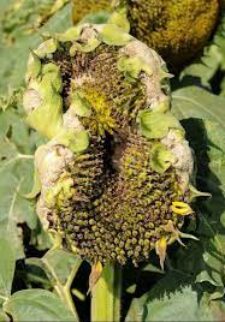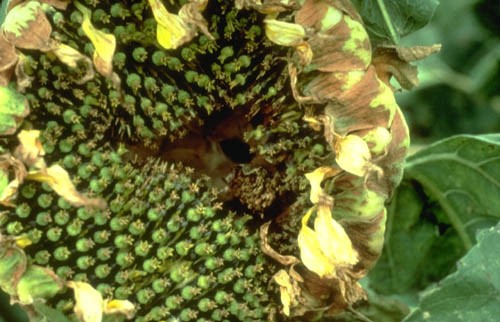Manitoba Farmers Participate in 2023 NSA Sunflower Survey

In alternate years, the National Sunflower Association performs a sunflower survey in six states (ND, SD, MN, CO, KS and NE). The survey looks at several agronomic pests and pressures and the potential yield impacts in the given year. In 2023, Manitoba Crop Alliance (MCA) participated in the survey with the help of Ahmed Abdelmagid, research scientist for oilseed crops pathology at Agriculture and Agri-Food Canada’s (AAFC) Morden Research and Development Centre. Nine sunflower fields were surveyed in Manitoba, reflecting the approximately 85,000 total sunflower acres in 2023.
This project serves two purposes:
- Identifying factors that affected yield in the given year and which may be of increasing importance in the future, and
- Identifying potential research priorities.
Factors that were looked at specifically during the survey were the following:
- Yield components – plant population, head diameter, seed size, % good seed, % centre seed set, bird damage
- Agronomic information – crop type, row width, tillage practices
- Weed Assessment
- Diseases
- Insect & bird damage
Fields were visited in mid- to late-September, once R9 was reached and each was surveyed at two different sites within the field. Of the nine Manitoba locations, six were oilseed production fields and the remaining three were confections, and all locations were distributed throughout southern Manitoba from Eastman to Westman areas.
The initial process in each sampling location was to do a plant count followed by another count including only “harvestable” plants (this would not include very small heads, heads with no seed, lodged plants). These harvestable plants were used in yield estimation against all the factors that lay ahead. Head diameter was measured in inches on five plants per location and centre seed set was measured (diameter of seed not set in the centre of each head). Next, seed samples were taken from three heads and stored in a paper bag to send for testing, but not before determining percentage good seed (% filled seed) and seed size.
A general assessment of the field was made at each sample location for yield limiting factors (birds, disease, insects, weeds, drought, uneven plant growth, hail, herbicide damage, lodging and plant spacing within the row) and the top two limiting factors were ranked. The most common limiting factor across the nine surveyed fields was disease (five fields) and the remaining four fields had greatest limiting factor being birds, drought, lodging or weed pressure. It was rare to find a second limiting factor in these fields, which had a positive impact on yield due to less pressure on the crop.
Bird damage was estimated in the percentage of seeds lost. Five fields had bird damage at the time of surveying, ranging from 0.5 – 4.5 per cent seed loss. Surveying is typically done around the same time blackbirds tend to begin feeding on sunflowers and one of these surveyed fields had a significant increase in bird damage by harvest.
Insect presence measurements accounted for sunflower midge, sunflower seed maggot, sunflower bud moth and long-horned beetle damage (not found in Manitoba). 25 heads at each field site were examined for the above insect damage, aside from long-horned beetle, which required stalk splitting to identify the larvae presence.



Disease observations and samples were taken of the following, when present:
- Root lodging
- Midstalk lodging
- Ground level lodging
- Sclerotinia wilt (basal stem)
- Sclerotinia mid-stalk rot
- Sclerotinia head rot
- Rhizopus head rot
- Downy mildew
- Phomopsis stem canker
- Phoma black stem
- Verticillium wilt/leaf mottle
- Charcoal rot
- Rust
Lodged plants were identified, on average, at the nine locations as follows:
- Root lodging or percent root upheaval – 2 per cent
- Ground level lodging – 1.5 per cent
- Mid stalk lodging – <1 per cent
Sclerotinia infections were significant, but averaged across all nine locations, the per cent instances are quite insignificant:
- Sclerotinia wilt (basal stem) – 4 per cent
- Sclerotinia mid-stalk rot – 3 per cent
- Sclerotinia head rot – 6 per cent
Other diseases were more significant in 2023 and this likely reflects most years, but stem rots tend to go more unnoticed unless lodging is a major issue. Rhizopus head rot was found in two locations, but samples are being tested for disease presence. Rhizopus is not a disease Manitoba sunflower farmers have had to deal with in the past, so further testing is being pursued to determine if this is a misdiagnosis or a real issue. Downy mildew and charcoal rot were not found in any of the sample sites. Verticillum wilt was found to be present on 2 per cent of surveyed plants and rust remained low with roughly 6 per cent infection area on leaves.
Phomopsis and phoma were the real diseases of concern in surveyed fields, which reflects the prior mention of disease being the most yield limiting factor in 56 per cent of surveyed locations. According to final yields, neither disease seemed to impact yield noticeably and lodging due to stalk disease did not occur. Phomopsis stem canker was found in 10 per cent and phoma black stem in 8 per cent of plants surveyed with diseased stalk samples being taken for further analysis. Phoma had very high incidence (80 per cent) across the entire survey in Manitoba and the six states, meaning 80 per cent of all plants sampled had phoma infections. Phomopsis was lower, at 34 per cent incidence in all samples, however this was noted to be an increase from past surveys. It is thought that Phomopsis stem canker prevalence increased due to any of the following factors:
- Susceptible hybrid
- Drought stress or other factors
- No fungicide use
- Wet weather closer to harvest
Weeds were generally not a concern in fields surveyed except for one that had lambs quarters and Canada thistle escapes and heavy pressure. It was this field that was identified as having weed presence being the primary contributor to any yield loss that was incurred.
MCA has applied for partial funding through the provincial government Sustainable Canadian Agricultural Partnership call for funding for the sunflower disease survey for 2024-27. During this time, they will be partnering with Agriculture and Agri-Food Canada to do disease verification of samples collected from the 2023 and 2025 season. This partnership allows further collaboration and cooperation with our NDSU partners to participate in their survey, bringing our members a larger dataset, with more information on disease tends.
